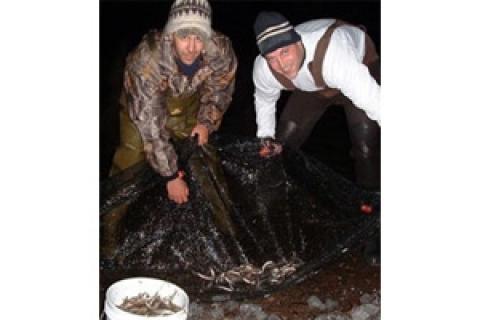
If you've ever traveled around the shores of Lake Michigan or Lake Superior during late April or early May, you may have seen a dazzling array of beach fires and individuals seining the ice-cold waters. Smelt, like many of the other Great Lakes species, instinctively swim towards gravel shores or spring-fed tributaries to continue their lifecycle during this time of year, bringing them close enough for anglers to catch a few. This annual event is one of the largest migratory runs of freshwater fish anywhere in the world.
 |
| Smelt swim toward gravel shores or spring-fed tributaries in early spring. |
Prolonged cold temperatures associated with the early spring will delay these migratory runs of smelt, and ideal water temperatures range somewhere between 42 to 45 degrees. These cool-weather conditions may also extend the season, giving anglers an extra long opportunity to catch a few extra for the freezer, but typical smelt spawning runs last seven to 10 days.
The smelt spawn begins at dusk, and it becomes its heaviest as complete darkness sets in. Smelt are sensitive to temperature and especially to light, so normally they keep to the mid-waters of the lake where they can descend deeper during bright daylight conditions. Smelt grow to an average size of 7-8 inches, but smelt around the 5-inch range are the best in terms of eating.
Armed with long nets and warm waders, as many as 25,000 smelters a year come far and wide to fish these abundant runs of migratory fish. The simplicity of fishing these tiny minnows makes them a prime target for many educated fisherman and a popular item at the dinner table. Actually, due to the fact that these little fish can be taken in large quantities, they make ideal finger foods for large parties, popularly known as "smelt feeds." Only a few inexpensive items are necessary to successfully catch smelt.
Supplies
- 15 to 25-foot seine net (check your local regulations before using a seine net)
- Waders
- Waterproof gloves
- Lantern and headlamp
- 5-gallon bucket
Start Catching
For the most part, anglers don't have to work very hard to catch these tasty little critters. Smelters simply need to stake out a small section of beach, preferably rock free, and wait until the sun begins to set. At dusk, two anglers carry the net out into the water, holding the poles high above their heads so that the net remains clear of the water, wading as deep as they can go. Keeping the net above the water allows the smelt to continue running towards the shore without being spooked by the smelters as they wade into the water.
When smelters are ready to begin the harvest, they place the net poles down on the lake bottom and begin to work their way back to shore. The smelters should slowly work their way into shore while dragging the poles along the bottom with the seine net dragging behind, trapping smelt that are trying to swim away. A slow and steady pace should be used by the smelters so that the net keeps contact with the lake bottom during the entire drag, leaving no chance for the smelt to escape.
Take small steps and keep a keen eye out for slippery rocks as you work your way towards the shore. There is no better way to ruin your evening than by stumbling over a large rock and taking a dip in the cold water.
 |
| Keeping your net running along the bottom and off of the rocks will keep the smelt from escaping as you bring your seine to shore. |
As you get closer to the shore, try keeping the net as wide as possible and angle the poles so that the bottom is pointed towards the shore. As you get closer to the shore, you will begin to see smelt swimming back and forth trying to escape. Pick up the pace a little and slide the net out of the water onto the beach making sure the bottom of the net does not lift off of the bottom.
Once you have the net out of the water, examine your catch carefully. Other game fish frequent the beach during the smelt spawn, and they, too, will get caught in your nets. To avoid fish injury or mortality, identifying these fish and release them as quickly as possible. Then pick out your smelt and place them into a cooler or pail.
Keep the fish you catch fresh by adding ice or cold water to your harvest. Chilling them lightly is important if you plan on cleaning them later on in the night. Just to warn all you first-time smelters out there: it usually takes twice as long to actually clean the smelt as it does to catch them. Therefore, if only a few people are involved in this smelting adventure, one five-gallon pail of smelt will take a few hours to clean and package for the freezer.
Cleaning
Cleaning smelt is not as bad as it sounds. A pair of scissors and some running water is really all that's needed. Clip of the head and the belly, and then run your finger up the body cavity to dispel the innards. Follow this with a quick wash under cool water to finish things up. If you plan on storing the smelt in the freezer, using a food packaging system to get the air out of the freezer packages will help prevent freezer burn from ruining your catch.
Smelt fishing is a social event in which the whole family can participate and enjoy. Be it the thrill of the catch, the stories around the fire, or the camaraderie of working together, smelt fishing will be some of the most fun you'll ever have in the outdoors. But remember — just as quickly and mysteriously as the smelt appear on the beaches, so too shall they disappear until the next spawning run.
- 22374 views

